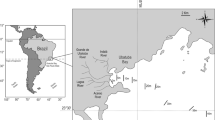Abstract
The portunid crabScylla serrata (Forskål) is shown to migrate offshore to spawn. Records of 447S. serrata caught as bycatch by trawlers in the tropical waters of northern Australia were analysed with respect to area, depth, distance offshore and month of capture as well as the sex and size of the crabs and whether the females were ovigerous. The crabs were caught mainly in three areas that correspond to the tiger prawn trawl fishery, at between 10 and 60 m depth (mean 28.5 m), 3 to 95 km offshore (mean 17.9 km). Most (87%) of the crabs were captured in October and November, which suggests they move offshore in September and October. No crabs were reported from offshore by February. Over 97% of the crabs caught offshore were female, of these 61.5% were ovigerous. The size range of females (100–109 to 200–209 mm carapace-width size classes) and males (120–129 to 200–209 mm carapace-width size classes) caught was similar. The frequent occurrence in coastal waters of females that are larger than the modal size at spawning, as well as mature females with spent ovaries, suggests that many females return to the coast after spawning. Although some species of portunid crab are euryhaline, mature females of estuarine species migrate to the sea to spawn. The migration byS. serrata described here is far more extensive than would be required to reach sea water salinities; it probably provides a dispersal mechanism for larvae to enable the megalopa stage to recruit to habitats distant from those of the parents.
Similar content being viewed by others
References
Arriola FJ (1940) A preliminary study of the life history ofScylla serrata (Forskål). Philipp J Sci 73:437–454
Brick RW (1974) Effects of water quality, antibiotics, phytoplankton and food on survival and development of larvae ofScylla serrata. Aquaculture, Amsterdam 3:231–244
Cresswell GR, Wood JE (1977) Satellite-tracked buoy data. Report 11. Tasman Sea releases November 1976–July 1977 Rep Div Fish Oceanogr CSIRO Aust 91:1–23
Crosnier A (1962) Crustaces decapodes, Portunidae. Faune Madagascar 16:1–154
Dell RK (1964) The large Indo-Pacific swimming crab,Scylla serrata (Forskål) in northern New Zealand. Rec Dom Mus, Wellington 5(8):59–62
Epifanio CE (1988) Dispersal strategies of two species of swimming crabs on the continental shelf adjacent to Delaware Bay. Mar Ecol Prog Ser 49:243–248
Heasman MP, Fielder DR, Shepherd RK (1985) Mating and spawning in the mudcrab,Scylla serrata (Forskål) (Decapoda: Portunidae), in Morton Bay, Queensland. Aust J mar Freshwat Res 36:773–783
Hill BJ (1974) Salinity and temperature tolerance of zoeae of the portunid crabScylla serrata. Mar Biol 25:21–24
Hill BJ (1975) Abundance breeding and growth of the crabScylla serrata in two South African estuaries. Mar Biol 32:119–126
Hill BJ (1976) Natural food foregut clearance-rate and activity of the crabScylla serrata. Mar Biol 34:109–116
Hyland SJ, Hill BJ, Lee CP (1984) Movement within and between different habitats by the portunid crabScylla serrata. Mar Biol 80:57–61
Norse EA (1977) Aspects of the zoogeographic distribution ofCallinectes (Brachyura: Portunidae). Bull mar Sci 27:440–447
Ong KS (1966) Observations on the post-larval life history ofScylla serrata (Forskål) reared in the laboratory. Malay agric J 45:429–443
Perrine D (1978) The mangrove crab (Scylla serrata) on Ponape. Trust Territory of the Pacific Islands, Marine Resources Division, Ponape, Eastern Caroline Islands
Pillai KK, Nair NB (1968) Observations on the breeding biology of some crabs from the southwest coast of India. J mar Biol Ass India 15:754–770
Robertson WD, Kruger A (1994) Size at maturity, mating and spawning in the portunid crabScylla serrata (Forskål) in Natal, South Africa. Estuar, cstl Shelf Sci (in press)
Quinn NJ, Kojis BL (1987) Reproductive biology ofScylla spp. (Crustacea: Portunidae) from the Labu estuary in Papua New Guinea. Bull mar Sci 41:234–241
Sachse M (1994) Monitoring systems. In: Pownall PC (ed) Australia's Northern Prawn Fishery. NPF25, Cleveland, Australia, pp 165–169
Shanmugam S, Bensam P (1980) On the fishery for the crabScylla serrata (Forskål) at Tuticorin during 1974–75. Indian J Fish 27:102–111
Smyth PO (1980)Callinectes (Decapoda: Portunidae) larvae in the Middle Atlantic Bight, 1975–77. Fish Bull US 78:251–265
Somers IF (1988) The Northern Prawn Fishery. In: Williams M (ed) Proceedings of the Workshop on Scientific Advice for Fisheries Mamagement. Australian Govenment Publishing Service, Canberra, pp 36–43
Taylor B (1994) Chronology of closures. In: Pownall PC (ed) Australia's Northern Prawn Fishery. NPF25, Cleveland, Australia, pp 171–174
Author information
Authors and Affiliations
Additional information
Communicated by G. F. Humphrey, Sydney
Rights and permissions
About this article
Cite this article
Hill, B.J. Offshore spawning by the portunid crabScylla serrata (Crustacea: Decapoda). Mar. Biol. 120, 379–384 (1994). https://doi.org/10.1007/BF00680211
Received:
Accepted:
Issue Date:
DOI: https://doi.org/10.1007/BF00680211




